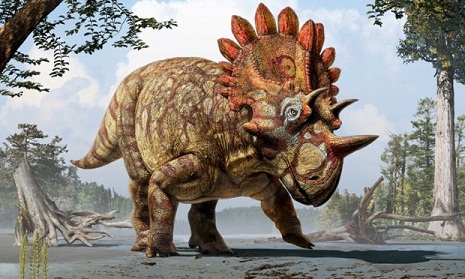The near-complete skull of the 70 million-year-old beast was spotted by chance 10 years ago, protruding from a cliff that runs along the Oldman river south of Calgary in Alberta, Canada.
Painstakingly excavated, cleaned up and measured since then, the fossilised remains have now been identified as a relative of the three-horned triceratops, and the first example of a horned dinosaur to be found in that region of North America.
Like triceratops, the new species was a herbivore. But it sported a more impressive shield, or frill, at the back of its skull, decorated with large triangular and pentagonal plates. The extraordinary features led researchers to name the new species Regaliceratops peterhewsi, a reference to the impressive crown-like frill, and to Peter Hews, a Calgary-based geologist who first spotted part of the skull jutting from the rockface in 2005.
Researchers came up with the Hellboy nickname long before they had liberated the full skull from the cliff face. The main reason was that the rock the fossil was embedded in was incredibly hard, making excavation a hellish, and years-long, task. That job was made even tougher because the Oldman river is a protected fish-breeding ground, meaning the scientists had to erect a dam at the site to prevent debris from the excavation falling into the river.
“It was a coincidence, but when we noticed that the skull had these short horns over the eyes, that really solidified the nickname,” Caleb Brown at the Royal Tyrrell Museum of Paleontology in Alberta told the Guardian. In the Hellboy comics and movies, the eponmymous demon grinds his horns to stumps with an electric sander to help him fit in with mere mortals.
But the horns of the dinosaur tell a more interesting story. Triceratops belonged to a group of horned dinosaurs called chasmosaurines. These had a small horn over the nose and two larger horns over the eyes. And while regaliceratops is definitely a chasmosaurine, it has a long nose horn and puny horns over its eyes. These features, opposite to those characteristic of triceratops, are seen in a different group of horned dinosaurs, called centrosaurines, which were extinct by the time regaliceratops came along.
The bizarre mix of features is an example of convergent evolution, where one species evolves bodily characteristics that arose separately in other species through the course of prehistory. Brown and his colleague, Donald Henderson, describe the creature’s remains in Current Biology.
“This is a really interesting new dinosaur,” said Steve Brusatte, a vertebrate paleontologist at Edinburgh University. “It’s a close relative of triceratops, but it’s horns and skull frill are very different. They look a lot more like other types of horned dinosaurs that lived earlier in time, which went extinct before triceratops thrived.
“What it’s indicating is that there was massive convergence between the horns and frills of those horned dinosaurs that were thriving during the final few million years before the asteroid hit and killed off the dinosaurs. Because this new dinosaur is one of the latest surviving horned dinosaurs, living at a similar time as triceratops, it is also telling us that horned dinosaurs remained quite diverse right until the end. To me, this is a strong hint that these dinosaurs were at or near the top of their game when that asteroid fell out of the sky,” he said.
More about:
















































